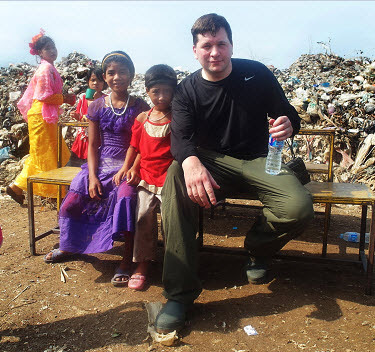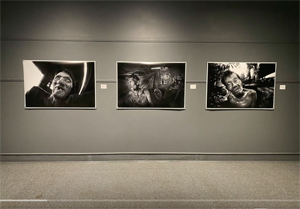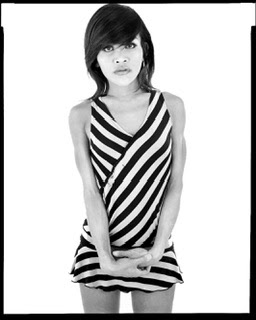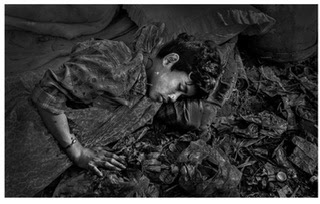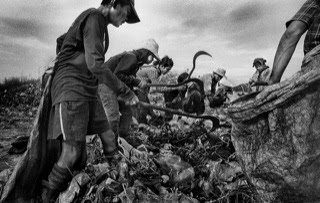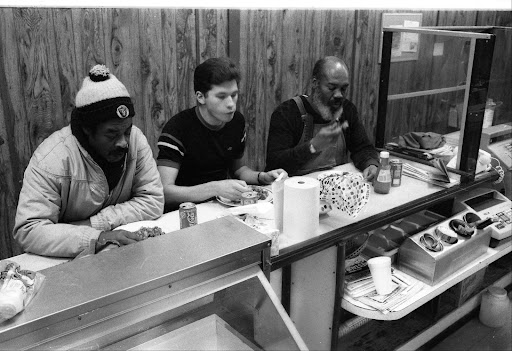Chris one of the folks in charge of the "TRUMPET" put a bunch of questions to me about the "Families of the Dump" series. I am going to speak to him on the phone tomorrow, but I thought I would also give him a LONG WINDED email version as well. I tend to do better in blogs and emails than I do answering questions live! Here is his email and my response.
------------------------------------------------------
--------------------------------------
I will call you at 12 noon tomorrow but I also wanted to answer your questions in email form. I do better when I have time to think things through carefully. Tonight I am printing for "TRUMPET" and thinking over your questions. Here are the written form answers. We can talk about them in more detail when I call you. The answers below are rather long winded, be forewarned!
That is a real danger, and something I have thought about a great deal. Documentary work can be exploitative if you’re going about things the wrong way or for the wrong reasons. Years ago I asked Lisa about it. She came up with an answer that satisfied me, a simple way to judge what was right and what was wrong. She simply said to me "WHY ARE YOU DOING IT?". I think that is the answer. What motivates you to make the pictures? Why are you making the photographs? Why are you there? After you make the photos, what will you do with the work?
The documentary photographer knows if he is exploiting a person or a situation. They know in their hearts what their TRUE MOTIVATIONS are.
Why am I photographing "The Families of the Dump"? I am doing it to document-educate, to experience-understand and to help my subjects directly through the creation of the art work.
Not exploiting also has a very personal one on one element. You treat people you photograph with kindness and courtesy, ask permission before shooting, do not photograph those that do not want to be photographed etc. There are also times you simply do not make pictures out of respect for your subject. When I am photographing I do that quite often. During my documentary photo series "My Fathers Last Days" I put down the camera many times, and just simply helped my father, turned away to offer him privacy, told him I loved him or gave him a kiss. If you have heart and purpose in your work you know when it is right to make a picture and when it is not right. I always try to follow my heart.
Here is one of the blog page donation links, lots more on the site, I wrote about it several times.
------------------------------------------------------
Hello Gerry
................................
................................
I have been reading your statement and viewing the images several times. I wish to discuss with you What the images really means? Will these images be understood by the viewers and if so what do you expect them to take away from it? I want to know what it means to be a documentary photographer in the 21st century? As a documentary photographer visiting foreign lands and photographing outside of your own culture do you ever feel you are exploiting your subjects? Or is all documentary photography, by its nature, a form of exploitation? I do know that you are very involved with photographing people in Thailand, I am curious as to what made you want to record the lives of people in Thailand. I would like you to talk more about the notion of political realities and your artwork. These are my questions that I have at this time. Naturally I may ask questions to clarify what you answer.
You are also invited to ask me any questions regarding the exhibition Trumpet. I look forward to talking.
Take care
---- ------
Chris...
I will call you at 12 noon tomorrow but I also wanted to answer your questions in email form. I do better when I have time to think things through carefully. Tonight I am printing for "TRUMPET" and thinking over your questions. Here are the written form answers. We can talk about them in more detail when I call you. The answers below are rather long winded, be forewarned!
What the images really means? Will these images be understood by the viewers and if so what do you expect them to take away from it?
That depends, for every person the work might mean something completely different. Different folks have different experiences, knowledge and backgrounds that will affect the viewing of the photographs.
For example when I showed the work "My Fathers Last Days" which deals with my father’s last year of life with pancreatic cancer, it meant different things to different viewers, some took it extremely personally. Many related the photographs back to persons in their own lives who they had lost to cancer.
I am not sure what the viewer will take away after seeing the “The Families of the Dump” work. I hope they will have a greater understanding of what those lives are like. I hope they will see the strength of these people and their wonderful humanity. Being with the families for the last 3 years has helped me grow personally; I hope gallery viewers who see the photographs and hear the stories will also have positive, productive personal emotional experience.
As to what the "Families of the Dump” work means to me? They are photographs about the ability of people to overcome immense personal hardships, to survive and grow in the most trying and adverse conditions. They are about individual strength, sadness and yet contain the joy of what it is to be a human being. They are to me about the true power and beauty of the human spirit. They are about the ability to overcome great injustice and still be a kind, loving and caring. In my opinion the pictures are about the best parts of what it is to be human, our individual strength, courage, and the beauty, love and the importance of family.
I would like you to talk more about the notion of political realities and your artwork.
Political realities? I try not to think of things in such broad terms. My relationship is with the person I am photographing, telling their story, which is all I really care about. I see them and only them, I relate to them and only them.
I am a simple man, living a simple life, I try not to verbalize grand political themes or make pompous artistic manifestos. I have always felt that kind of stuff was too large, too distant and too grand for little old me. That is one of the reasons I use "Gerry Yaum" for my photography, that is not my real name, who cares about me, the photos, the stories in the photos are all that matters. My subjects are all that matters. Me, my arrogant thoughts or having my real name on a gallery wall is of no importance. Having the subjects on that wall thou is different, it is very important, telling their stories is what matters most.
When I am making the pictures I relate to the child I am photographing, see that child's eyes, and try to tell that dump or slum child's story. I will leave the high art things and the politics for others to figure out, people smarter than myself. I simply want to tell the stories of my subjects. Nothing else really matters to me, I try not to over think things out too much. I just follow my heart and see where it takes me. Photographing the lives of forgotten people is what matters, I will let all the other political and or arty farty stuff fall where it may. Everything else will work itself out. I just make my pictures.
As a documentary photographer visiting foreign lands and photographing outside of your own culture do you ever feel you are exploiting your subjects?
That is a real danger, and something I have thought about a great deal. Documentary work can be exploitative if you’re going about things the wrong way or for the wrong reasons. Years ago I asked Lisa about it. She came up with an answer that satisfied me, a simple way to judge what was right and what was wrong. She simply said to me "WHY ARE YOU DOING IT?". I think that is the answer. What motivates you to make the pictures? Why are you making the photographs? Why are you there? After you make the photos, what will you do with the work?
The documentary photographer knows if he is exploiting a person or a situation. They know in their hearts what their TRUE MOTIVATIONS are.
Why am I photographing "The Families of the Dump"? I am doing it to document-educate, to experience-understand and to help my subjects directly through the creation of the art work.
- To Record - educate: The lives of the families are hidden from the world, invisible to our eyes and thoughts. Is it better to ignore them, their suffering, their joys and sorrows, who they are as people? If I do not go there to tell these very important stories, who else will go? Who will tell the stories of the young children working the garbage, young children that will later become the old people working the garbage. These lives are unseen, these untold stories need to be told! My job is to tell them.
- To Experience - understand: Everything I do as an artist changes who I am. Years ago I photographed young women working in brothel in Cambodia. That very difficult experience shaped who I am today. I am still haunted by those thoughts, they affect my actions in everyday life and as an artist. Those memories and photos helped solidify my path as a documentary photographer.
The "Families of the Dump" series also changes who I am. After photographing in the dump in 2013 I came back to Canada and within a few days was having Christmas dinner with my family. We had turkey, ham, meatballs and gravy. We had pyrogies and cabbage rolls, periske and deserts. We had everything imaginable on that table, food left over and not eaten. I kept thinking back to the men and women, the children in the garbage, and the lives they lead, the foods they ate, the places they slept, the heat, the cockroaches, the wild dogs and rats. My mind kept flashing back over and over again to the dump as I ate, I could not relate to my family that night, I felt apart. Memories (experience) is an important part of the life’s story to me, it helps me grow and develop as a person. It puts my life in perspective and helps me to understand the greater world.
I think this is an important part of not exploiting your subject. You need to understand who they are and their lives need to affect you on a deep and personal level. When you feel that deeply for Long or Nong, Anapon or Chemeeko how can you exploit them? You would not be able to live with yourself if you did.
- To Help: My friend photographer Larry -----, taught me to try to give as much as I take. Since I started photographing the dump families back in 2013. I have delivered probably 80-100 individual gift food bags to the different dump family shacks (each bag would contain rice, canned fish, soap, toiletries, noodles, donated hats etc.).
I have also made personal donations of money to the local school that helps the dump children as well as bought dozens of boots, head lamps etc, for people in the dump. Over the last 3 trips I even brought 10 pairs or so of heavy duty safety boots donated by plant site where I work as a security guard. For my trip in April/May 2016 the plant -------- ------- -----------had a fund raiser, a noon hour hot dog lunch function that raised $500 for the families. That money I later donated to an organization that helps the families in the dump. The money was used for dump children tuition fees and for school uniforms. People at my work site also donated personal money, toys and the hats that I placed in the food donation bags.
So documentary photography can be a force for good in the world, it can lead to direct help. The people in the “Families of the Dump” documentary photographs have received financial aid/food aid/ dump work gear supply aid as a result of the photographs. The people I worked with had seen the families, seen their lives in various online documentary photo links, it influenced them in a positive way.
Here is another example that will happen later this year. I intend to donate the artist fee I get for the "TRUMPET" exhibition to the families when I return to Thailand in October of 2017. I hope to donate it to pay for school tuition fees for the children of the families who work the garbage. It is a perfect circle of life. I take the photos, I show the photos in Canada (creating art while educating and informing), get paid an artist fee, then I return to Thailand and give the money earned back to the people in the photographs, PERFECT! To me that is the true power and beauty of documentary photography, helping your subjects.
I hope in the future more shows will result, more education will occur, more money will be raised, more direct help can be given. That then leads to more "documentary art", more stories being told, one positive leading into yet another.
Not exploiting also has a very personal one on one element. You treat people you photograph with kindness and courtesy, ask permission before shooting, do not photograph those that do not want to be photographed etc. There are also times you simply do not make pictures out of respect for your subject. When I am photographing I do that quite often. During my documentary photo series "My Fathers Last Days" I put down the camera many times, and just simply helped my father, turned away to offer him privacy, told him I loved him or gave him a kiss. If you have heart and purpose in your work you know when it is right to make a picture and when it is not right. I always try to follow my heart.
Here is one of the blog page donation links, lots more on the site, I wrote about it several times.
http://gerryyaum.blogspot.ca/
I do know that you are very involved with photographing people in Thailand, I am curious as to what made you want to record the lives of people in Thailand.
I guess this question is about the history of my Thai work. It is as follows. I have always found people living different lives than my own of great personal interest. I’ve always asked. Who are they? What makes them the way they are? What can I learn from them, what will they teach me? What stories can I tell with my photographs?
My initial interest in Thailand was trying to understand and photograph the lives of the female sex worker, the bargirls of Thailand. My first trip was way back in 1996. I saved some money, gathered a bunch of photo gear, read one book on Thai culture and dived in head first. I was like a babe in the woods, completely unprepared for what I would experience and encounter. Going to Thailand that first time was truly a life altering experience for me.
Later on I expanded the sex worker series photos, past the female worker to the male and transgender workers (ladyboys). Understanding and expressing those important stories in photographs obsessed me. I needed to tell everyone about these forgotten lives. It all became extremely important to me. I hung with the workers, trying to understand their points of view, I hug with the sex tourist/sex pats trying to understand things from their angle as well. The more people I met the deeper I was drawn in. I learned to speak a fair amount of Thai, even learned to read and write some. I studied the culture, Buddhism, the history of the bought sex world in Asia both for tourists and local men. Over a 16 year period I photographed the sex workers of Thailand/Cambodia in numerous ways, sometimes photographing the same people over several years as they aged and changed.
That resulted in this exhibition:
It also led to wanting to photo non sex work subject matter. I had grown so tired of that world. Some of the bar workers in Bangkok lived and worked out of the Klong Toey slum, so that was my next project, the lives of people in the slum, recording who and what they were.
That resulted in this exhibition:
Now this latest series on the dump families has expanded that thirst to understand and express through photography the lives, the stories of others. Who knows where this series of pictures will lead. All I know is I love art, love photography, love entering and experiencing different worlds, different lives. I will keep doing it for the rest of my life.
Thanks for taking the time to read my ramblings Chris, I hope this helps answer some of your questions.




